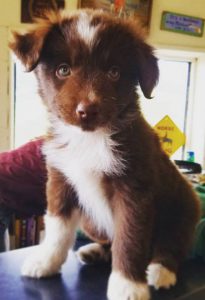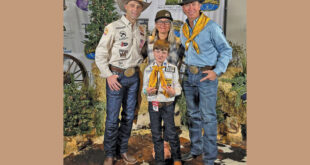By Dawne Belloise
Last week, in part I of Working Like a Dog, we learned about the lives of service dogs and avalanche dogs. This week, we get a peak into the lives of cattle dogs and sled dogs.
Cattle Dogs

Cattle dogs have been part of this valley for generations, although it’s a personal preference as to whether or not ranchers use dogs. Barbara East has been training and using cattle dogs in her horseback rides for forty-five years as a range rider and attests that they are canines that are not to be trifled with. They’re serious about their work. Barbara uses cross breed dogs, “Half something and half something else, usually Kelpie, border collie, and McNab mixes. You have two kinds of dogs for cattle, driving dogs and gathering dogs. Some bring the cattle to you, others drive the cattle away. Training is just using them. You just put them on the job, they’re bred to do the work. You do have to train them, basically, by putting them in the field and using them. Border Collies need a job. You can’t just leave them idle for too long. Their place on earth is not to watch the house. They’ll work as opposed to chasing a stick or eating. It’s ridiculous and amazing and in fact you really have to watch them because they’ll work themselves into the ground.”
As far as training them, Barbara feels you’re just rewarding and recognizing them for what they already know and bred to do. “They just need for you to establish the direction you want to move the herd. One thing about border collies that I find amazing is they watch your body language. They will watch what I watch and soon they are pretty much thinking what I think, then, good dogs will balance their position opposite of mine. They’ll go where I can’t go to get cattle, then we begin to turn into a pretty good team. Border collies are more of a fetching dog, they’ll fetch a sheep, they’re gatherers. The blue heelers, they’re a more aggressive and pushy dog, so they push the cattle. I’ll use the blue heeler breed that people now use for pets. They were famously bred to bite, to drive cattle away from you, by nipping the heels of cattle. But as people began to like them as pets they bred the nip out, and they’re not bred for working anymore. Twenty-five years later, you don’t have working dogs anywhere. It’s getting harder and harder for people using stock dogs to get them because they’re breeding them more for pets.” Barbara notes that really good stock dogs don’t make good pets because they’re bred to do their jobs. “If they don’t have a cow to bite they’re going to bite a bike rider or something.”
The north end of the Gunnison valley is Barbara’s range, riding for several ranchers. She’s fourth generation from a ranching family in Boulder. She came to Crested Butte in 1968 and has been using dogs ever since. “A dog out there isn’t a pet for us, it’s a tool for our job. They’re working dogs. Their whole world revolves around praise but they’re not dogs you pet. They have a job and they have to focus, it’s just a different deal. They’re my hired hand, when they’re done with their work, you praise them. Giving them the continuing opportunity to work is their greatest reward.
“I work dogs on 215 square miles, and these dogs have a tremendous vocabulary,” Barbara explains the dogs are exceptionally smart and can differentiate between left and right for directions, using the terms “way” for right and “by” for left. If you want a dog to go further around to the right you say “go way on,” and for further around to the left, “on by.” Barbara explains that cattle dogs key into your level of excitement, “If you want to calm them you say ‘easy.’ It’s all tone of voice. The dogs will lay down or sit if you holler ‘stop.’ If you want to change directions after sending the dog right or left you call ‘here,’ if you want to direct them away, the command is ‘here back.’” When a day’s work is over for her dogs, they get the praise, “When they’re all done they do get petted and shown appreciation at the end of a hard day’s work.”
Sled Dogs
At the Lucky Cat Dog Farm, Becky Barkman’s mushers love their jobs, and like cattle dogs, they’re naturals at what they do, pulling sleds as a team.
“They’re like a lot of dogs—they come by it naturally. I let the youngsters run alongside the team. I let them watch and they take it from there,” Becky says of the training. “Dogs like to run and they like to run with their friends.” Becky starts dogs at the ages of seven to eight months, when their bones and joints are set and they can actually start pulling weight.
She’ll run a 10-dog team on the sleds and maybe six or seven on smaller sleds with lighter loads. Sled dogs’ work longevity can vary and Becky says, “I have a dog who’s 10 and I take her once a week and she rips it up.” She uses Alaskan huskies, which she explains, aren’t a breed.
“They’re a type of dog that came out of the Alaskan gold rush. There weren’t enough dogs in Alaska to do the work in the late 1800s. There weren’t designer dogs. The breeds got mixed with the local dogs. Since then they’ve bred in whatever they needed, using traits from pointers, border collies, greyhounds, fox hounds and other breeds they’ll cross with generic huskies. You get a very tough, smart, sensible and healthy dog because it’s a deep genetic pool.”
Becky used to breed her own dogs but when one of her favorite lead dogs died five years ago, while taking the dog to be cremated, a pick-up truck pulled up loaded with the bodies of dogs put down by shelters. Becky felt she wanted to make a difference in that number of useless killings.
“It’s a crime. It gets me wound up. I get my dogs from the shelter now and other mushers that have too many. All my dogs are fixed [neutered] and most mushers don’t do that.”
Becky’s mushers run about 15 to 20 miles a day. When the dogs get back from a run, they get water at the trailhead, and it’s then home for lunch. “And they get lots of love, all the time,” Becky smiles. “Some people think it’s cruel to make animals work, but ‘make’ is the wrong word to start with because you can’t make dogs go if they don’t want to.”
After they run, when they’re at rest in their yards, none of the dogs are pacing or howling, Becky points out, because all of their needs are being met, including exercise, discipline, and affection, and their needs for rules, boundaries and limitations. “If a dog isn’t exercised they won’t do anything. It calms their minds down. They’re in a happy place.”
For more information about Lucky Cat Dog Farm visit www.luckycatdogfarm.com.
 The Crested Butte News Serving the Gunnison Valley since 1999
The Crested Butte News Serving the Gunnison Valley since 1999


